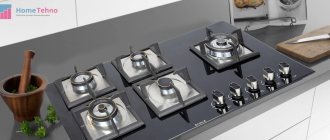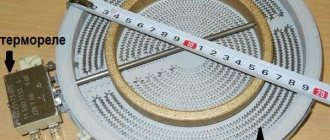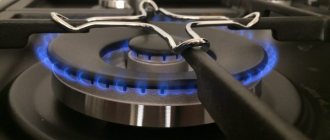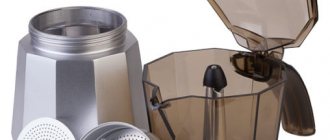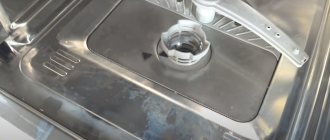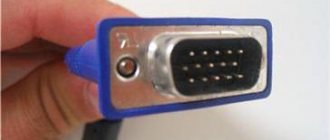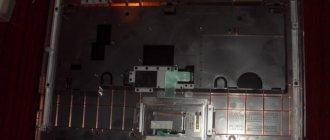In order to connect a gas hob, it is recommended to officially contact specialized organizations that have a license and certain documents to perform these types of work. If you decide to connect and install a gas hob, you need to understand an important issue: how to properly connect a gas hob. Also, for this you must know the safety measures and strictly follow the instructions.
Built-in gas hob
Preparation
The preparatory stage is very important when installing the panel.
The safety of the kitchen unit and the visual appeal of the room as a whole depend on the correctness of the calculations used for the insertion. An error of even 1 cm can cause damage to the tabletop. It is recommended to focus on the dimensions prescribed by the equipment manufacturer in the instructions.
Measurements
The dimensions of most panels are the same - 55-57 cm
You need to pay attention to the size of the hole for installing equipment. To take certain measurements you will need a tape measure
The panel is turned upside down. The length and width of the equipment is then measured along the inner edge.
It is worth noting that the instructions indicate the minimum distance from the edge of the tabletop. It is not recommended to reduce it, but you can increase it. Failure to comply with this rule may result in surface breakage.
Before cutting a recess, you need to make sure that the required distances are maintained between the slab and surrounding objects. These numbers are usually written on the operating sheet.
How to connect a hob - step-by-step installation and connection instructions (80 photos)
It is difficult to imagine technological kitchens without energy-consuming appliances. The main assistants: a stove, a refrigerator and a sink are indispensable attributes of the current kitchen space. If connecting a refrigerator is simple, you only need an socket into which you plug a plug, then connecting the hob needs to be done thoughtfully.
The appearance, design and principle of operation of plates placed on countertops are varied. The gallery shows photos of hobs from different manufacturers.
Three basic types are sold: electric, gas and combined. The names explain the principle of operation, the first ones use electricity, the second ones heat the burners by burning gas, the third ones use both heat sources.
Before purchasing, you need to make a calculation of the electrical wiring based on the power consumption of the stove and oven. Apartments in old buildings cannot withstand heavy loads; they don’t even have simple grounding. In this case, an overrated automatic machine will not help; the wiring will overheat.
An electric hob of any type must be connected by a separate wiring line directly from the distribution panel.
The kitchens of the new apartments are equipped with separate wiring for stoves, automatic switches and grounding. The cross-sectional area of the conductors is at least 3.5-4 mm.
Connection methods
A ready-made, thoughtful kitchen design will help you decide how to connect the hob to the power supply. Two ways:
Directly. Pull the wire from the distribution panel to the panel terminals. The cable cross-section is selected depending on the power of the stove.
The electrical wiring made must be protected, and additionally have a switch to turn off the stove in an emergency. The length should be sufficient and comfortable when connecting, and not dangle.
The wiring can be hidden and led out near the connection point. Exposed wiring is simply mounted on the wall.
Through a socket. In new apartments designed for the use of electric stoves, a power outlet is already installed in the kitchen.
The selection of the plug is made according to the rated current for the kitchen appliances being installed, so when purchasing a stove and oven, you should find out their electrical characteristics from the seller. The plug and socket inputs are connected to the terminals according to the designated diagrams.
Networks in houses are single-phase and three-phase. Based on this factor, a power socket with 3 or 4-5 connection pins is taken.
A flexible multi-core connection cable is required, with a core cross-section no smaller than that of the wiring. You should calculate the length of the cable from the outlet to the connection point; there should be no excessive tension, sagging, or twisting into rings.
The cable should not be heated by hot stoves, ovens or other hot objects. It is strictly prohibited to place the connecting wire on the floor.
How to connect the hob and oven?
An independent electric oven is connected separately, the combined panel is connected to the oven through terminals according to the attached diagram. Manufacturers of kitchen appliances make connections and terminals in their own way. But everyone has “ground, zero and phase”, only the number of phases varies.
If the apartment wiring is single-phase, the stove is connected by first connecting the ends of the phase with a jumper. Manufacturers supplement the equipment set with jumpers suitable for connection.
The installation instructions show you how to connect the hob yourself. The diagrams are shown on the back of the instrument housing. From several options for cases of different numbers of phases and pins, you should choose the appropriate one.
Example. Electrolux stove models are equipped with two phase terminals. They can be connected to two separate phases or pre-combined with a jumper and connected to one phase for single-phase wiring of the apartment.
Subtleties of connection
Use insulated wire with the required number of cores and rated cross-section.
Check the installed sockets first, builders are people too, they can make mistakes.
Follow the connection order:
- Earth-earth;
- Zero zero;
- Phases one after another, if there are many of them.
How to connect a gas hob to electricity? The useful electric ignition function does not require a non-standard connection. A simple electrical outlet will do the job.
The requirements for the connecting cable remain the same: no tension, no sagging, no heating.
Connecting a hob requires a lot of skill; if you are not confident in your abilities, call an electrician.
What tools are needed to cut the hole?
To correctly connect a gas stove, use the following tools and parts:
- a flexible hose of the required length - universal - about 1.5 m, or individual rubber - from 1 m or more;
- ball valve made of brass with nickel coating, designed for operation in systems that supply subscribers with natural and liquefied hydrocarbon gas of low and medium pressure;
- keys – gas and adjustable keys;
- gasket - usually sold complete with the stove;
- screwdrivers of various types;
- sealing tape or thread - for example, FUM tape or Loktail 55 thread;
- medium concentration soap solution and a brush to check the correctness and accuracy of the connection for leaks.
READ MORE: Warm floor in a bathhouse from a stove, step-by-step installation instructions
As soon as all the necessary components are at hand, they begin to work directly.
Installing and connecting a gas hob requires certain tools. To cut a hole for the hob, you will need at least three tools: a milling machine (preferably a manual one), a jigsaw, and a drill. To make the hole perfect, it is best to use a manual milling machine.
You should stock up on a set of screwdrivers. A knife and spatula will come in handy. If you have a set of wrenches, then you need to prepare it too. Every home owner should have a drill.
You should start cutting the hole using a drill. As a rule, you end up with sloppy edges that have to be corrected later. It is better to take drills from 8 to 10 millimeters. Gradually, many holes are made around the perimeter of the future panel. Afterwards, using a drill, a slot is immediately made. It is important to understand that you can only drill from the inside of the countertop.
When a piece falls, it can damage the kitchen unit. It is better to place a chair or cabinet under it. Cutting with a jigsaw is much easier than with a drill. First, you need to use a drill to mark the hole that the person will cut. It is possible to do it without resorting to using a drill.
Care must be taken when installing a gas hob. It is important not to injure yourself or damage the furniture.
Features and nuances of installation
The installation rules stipulate that any work on connecting or moving the location of gas equipment must be carried out in accordance with current standards and rules, warning gas services about replacing the heating device. When purchasing a panel, it is better to immediately clarify how it is attached to the countertop. The material of the base itself also matters; if you can handle chipboard yourself, it is better to entrust cutting into artificial stone to professionals.
You can easily install hobs yourself. The main thing is to correctly mark the countertop on which the installation is being carried out. If the panel is purchased for a ready-made set, it is worth measuring the available width and thickness in advance, especially when the furniture module is non-standard, created to order. Typically, installation dimensions vary in the range of 55-57 cm. It is worth considering other important points:
- the connection to the pipe should be connected before installing the headset - this will simplify the installation of the nuts;
- installation of the bellows hose should be carried out not through the valve directly, but through a fitting or plumbing drain;
- when forming a connection, a linen winding must be used and coated with gas paste;
- if there is electric ignition, the connection point to the network should be removed in advance;
- to increase the level of safety, you can embed a valve with a thermal shut-off element in the pipe, which is activated when the temperature reaches 80 degrees Celsius;
- the hole cut in chipboard or wood must be carefully coated with sealant along the sides;
- By default, the hobs are supplied with nozzles for the main gas supply; to connect to a cylinder/gas holder, they must be purchased separately.
This is interesting: Typical electrical wiring diagram in a house: let’s understand it from all sides
Types of seals for gas systems
To connect a propane cylinder to a gas stove, you do not need to have any competence or special skills. All you need is a wrench and common sense. And don’t forget, after connecting, before starting cooking, use soapy water to check for leaks at the connections.
A detailed description of the process of installing a gas stove in an apartment with your own hands. Useful tips and interesting nuances of the process. Recommendations for using the tool.
How to easily and quickly connect a gas stove in a residential building, what hoses to choose and other related elements. Information about the cost of work.
Review of bellows hoses for gas stoves. Pros and cons of the parts and expert opinion on whether they are worth using.
The basic rules for connecting a gas stove in an apartment or private house are not complicated. If you carefully study the installation instructions, use the right tools and follow safety precautions, the process will go smoothly and will not take much time.
When there is no confidence in your abilities, it is better to contact the gas distribution company at your place of residence and invite professional craftsmen to your home. They will quickly carry out the installation and do everything in strict accordance with the regulations and generally accepted standards.
How to choose the right hose when connecting yourself?
It is important to be aware of the dangers of connection work, entrust this task to specialists, or work independently under the supervision of a qualified gas service worker. The main task is to choose the right hose
Before purchasing it, you need to check it for defects. A certificate must be included with the hose. It is given out in the store
The main task is to choose the right hose. Before purchasing it, you need to check it for defects. A certificate must be included with the hose. It is given out in the store.
You can purchase either a metal hose or a rubber one. The second option costs less than the first. They are usually plain.
Installation nuances
Kitchen hobs are gas, electric and induction. Each of them has its own characteristics and requires a specific approach to installation. But there are general rules that apply to all types of kitchen installations.
Before proceeding with installation, you need to make sure that the following nuances are observed:
- the presence of a ventilation system and an exhaust hood equipped above the stove or the presence of a powerful fan in the window;
- tabletop material with a heat resistance level not lower than 100 °C, and the surface itself is not thinner than 25 mm;
- if you plan to install a panel between two cabinets, make the distance between the walls and the stove at least 15 cm;
- the gap between the wall and the slab must be at least 5 cm, and if it is smaller, then heat-insulating material is laid.
Any discrepancy in the installation of equipment is fraught with its incorrect operation and the occurrence of a fire hazard.
Electrical panel
Electric stoves are especially popular among users. They are easy to use, durable and beautiful. If they break down, you can carry out repairs on your own without calling a specialist. Of course, if you do not have at least minimal knowledge in the field of electrical engineering, then it is better to leave the installation and subsequent repairs to specialists.
On the back wall of any built-in electrical panel there is a diagram according to which the connection is made. If you do something wrong, it can result in a short circuit and incorrect operation of the burners. Some models are equipped with a wire for direct connection of the stove to the panel. This eliminates the need to make an additional electrical point for the socket. Installation in this case consists only of connecting the cable to the panel, installing it in the hole made and sealing it.
Gas hob
The gas stove, built into the countertop, is installed by the owner of the equipment himself. But a representative of the relevant service must make the connection and check the fault.
Typically, gas panels are attached to the countertop using special brackets that come included. After installation, you can connect the power cable and open the gas supply. At this stage you need to be extremely careful and take into account all safety regulations.
You need to make sure there is no leakage. For this, a special gas analyzer or the “old-fashioned” method is used. The joints between the panel and the pipe are lubricated with a soap solution and the gas is opened. If bubbling is visible, there is a problem that needs to be fixed.
Installation rules above the oven
Induction panels have many advantages over gas and electric stoves.
The following advantages can be highlighted:
- the surface quickly heats up to a certain temperature;
- easy to care for and keep clean;
- savings in energy consumption;
- the absence of open flame and too high temperatures makes the equipment safe for children.
When installing a stove above the oven, you need to take into account some subtleties. The oven must be equipped with a cooling system and forced ventilation.
The countertop into which the panel will be mounted must be perfectly flat. If you neglect this rule, then perhaps the deformation will disrupt the normal operation of the equipment, and it will quickly fail.
Functional Features
One of the main functions is gas control of the burners, which is designed for safe use. Gas stoves are equipped with a timer, a digital display, and there is a thermometer inside the oven that shows degrees. The presence of additional functions leads to an increase in price, but they are not always used, for example, this applies to an alarm clock and an Internet access zone.
A gas stove with electric ignition is necessary for those who constantly cook and do not want to use matches or a lighter. This function helps to light the gas in a matter of seconds. Today, all well-known manufacturers produce models with built-in electric ignition.
Installation work
First of all, you need to determine the type of oven and hob. These elements can be dependent on each other and autonomous. If the first option is chosen, two elements are placed in one niche. In the autonomous version, the hob can be installed in the center of the unit, and the oven in any convenient place where the gas supply hose can be reached.
Connecting the gas oven cabinet and starting it up begins with installing the equipment in the niche of the unit. To do this, the back panel of the niche must be removed and the oven placed on two bars that are pre-attached to the surface of the furniture set. This will ensure ventilation of the oven and niche to avoid fire. Next we connect the electricity. This is necessary for the operation of the fan, electrical control panel and other mains-powered functions.
The next stage is connection to the gas supply system. This installation stage involves connecting the oven cabinet and gas pipe using a hose. It is also necessary to connect the hob to the gas pipeline. In this case, you can use a welded pipe connection. Before starting work, do not forget to turn off the gas supply to your house or apartment.
After the gas oven and hob are connected to the fuel supply, it is necessary to configure all functions of the equipment, check the functionality of the burners and the gas control system. The valve responsible for the gas supply is subject to checking and adjustment.
Detailed instructions for connecting a gas hob and oven are presented in the video.
We follow safety rules
When connecting the oven to the power supply, remember that the wire should never come into contact with the gas pipe. The maximum heating temperature of the conductor should not be higher than 70C. Do not use extension cords or double or triple sockets. All additional wires and connections may cause a fire. Before you start cleaning the oven cabinet, it should be disconnected from the electricity supply.
Before final completion of installation work, it is recommended to check all joints for gas leaks. To do this, use soap foam, which must be applied to the connecting elements. If, when you turn on the gas, the soap begins to foam in some places, it means there is a hole there. Once the crack and leak are repaired, you can safely use the equipment. https://www.youtube.com/watch?v=gZhAjE8tk2k To summarize, we note that it is better to entrust the gas connection to the hob and oven to professionals
In this matter, it is important to take all precautions in order to avoid future accidents. If you decide to make the connection yourself, it is recommended to study the instructions for the equipment from the manufacturer. Also, study in detail the advice of experts
Only with step-by-step installation work, subject to safety precautions, can gas equipment be connected on your own
Also, study the advice of experts in detail. Only with step-by-step installation work, subject to safety precautions, can gas equipment be connected on your own.
How to mark correctly?
The key to successful installation of a gas hob is correctly applied markings. The appearance of the kitchen unit will depend on this stage of work. A bulging or crookedly installed panel will immediately catch your eye. It is unacceptable to make mistakes in the markup. Even one centimeter can make a difference in the installation.
The place under the hob can be marked in two ways:
- Place it on the tabletop and trace the outline with a pencil. This method is considered the simplest.
- Make accurate calculations. This method will help avoid installation errors.
After the gas hob is installed in its intended place and connected to the mains, care should be taken to start it up and check the tightness of the connections formed. To do this, you need to open the gas valve (stop tap), check by ear and smell for leaks. If no problems are observed, you can begin to alternately turn on the panel burners. It is important to take into account that at first air comes out of the burners.
The pressure in the line is not too high, so you should count on it for up to a minute, after which gas should come out of the burner. After all the valves have been checked for functionality, you can install a supporting grid on the surface to place dishes and use all the capabilities of the cooking unit in normal mode.
If you have an electric fire ignition system, additional connection of the equipment to the power system may be required. To do this, provide a waterproof outlet in the access area to ensure uninterrupted power supply.
The main criterion for correct and accurate installation of the hob is compliance with safety requirements. Built-in gas appliances must be positioned in such a way that they can be connected to the main pipeline. The distance between the panel and the pipe can be varied through the use of a flexible liner. The distance from the riser is not regulated, but the standards provide for:
- maintaining a distance of at least 20 cm from the side of the heating source to the location where the shut-off valve is attached;
- with standard wiring, the connecting fitting should be located at the same level as the insertion point into the pipe;
- with an overhead connection, the height of the tap shutting off the gas supply must be at least 1.5 m from the floor.
Connecting a gas hob with your own hands
Connecting a gas hob is a more labor-intensive and serious process than an electric one. You can do all the work yourself, but you will need the presence of a gas service worker.
Advice. If you are not confident in your abilities, entrust the installation of a gas hob to specialists.
For those who still decide to install the gas hob themselves, step-by-step instructions with photos are offered.
- Selecting a panel installation location. The hob can be mounted anywhere on the countertop, regardless of the location of the gas communications. Gas is supplied to the hob through a corrugated hose in a metal braid. The limitation of the use of such hoses is the presence of automatic ignition in the gas panel.
- The hole for the panel is cut out in accordance with its dimensions.
- After the hole is ready, foam tape should be laid around the perimeter.
- Only after laying the foam rubber can a gas hob be installed on top.
- The next step is to connect the panel and the gas line using a hose. Invite a gas service employee to carry out connection work
- If your panel is equipped with automatic ignition, you will need to connect to the gas supply system. The best option would be to install a separate outlet next to the hob.
When choosing a gas hob, pay attention to the main criteria: surface material, number of burners, location of the control panel and additional functions. The choice of panel material determines how to care for it.
You can connect the gas hob yourself, but the presence of a gas service employee in this case is still required.
How to install a panel into a countertop
Independent connection of the surface first requires proper installation of the panel into the prepared cutout of the kitchen unit.
Installation is carried out in several stages:
- We determine the future location. Dimensions are determined with a ruler. It is most convenient to use a cardboard blank.
- Draw the shape of the panel on the board. A maximum of 1 mm can be left to allow the product to easily enter the panel.
- Drilling panel borders. Pre-drill in the corners of the marked shape. Diameter 9-10 mm. The drill must be made of wood or metal.
- The next step in installing the hob into the countertop is to cut a hole using a jigsaw. The tool is inserted into the finished hole, pressed firmly against the board, and then begin the cutting process. In this case, the brush should be pressed along the marking lines at low speed.
- Attach it securely from the bottom to the top of the table using a set of clamps. Then remove the remaining wood.
- The remaining gap must be filled with a special silicone sealant.
The process of installing a gas panel Source stroy-podskazka.ru
After installing the device in the set, you can begin the process of connecting it to the electrical network.
Connecting an installed hob
Electrical panel
It is advisable to provide a connection point for the electric hob before installing the kitchen unit. The socket must meet all electrical safety requirements:
- have a grounding line;
- The supply copper cable must have a cross-section of at least 4 square meters. mm.
A hole is cut in the back wall of the base cabinet opposite the electrical outlet of such a size that you can easily insert and remove the plug from the hob by hand.
Sockets installed for self-connection come in two types:
- three-pin;
- four-pin.
If there is a plug installed on the hob cord, then to connect it, just plug it into the outlet. The power cord must be of such length that it is not too tight when connecting the device.
Plugs and sockets for connecting hobs
For models sold without a plug, certain steps will be required:
- If the socket is three-pin and there are four wires in the wire, then you will need to connect a two-phase model to a single-phase network. To do this, wires with black and brown insulation are connected in the cord. This connection is connected to the socket phase. The blue neutral wire is connected to the socket neutral, and the green-yellow wire is connected to ground. All connections must be securely insulated.
- If the placement of the wires in the socket is unknown, then using a multimeter you need to determine the phase and zero. If necessary, they are swapped so that they match the wiring in the plug of the device.
Induction hob
An induction panel is connected according to the same general principles as an electric one. Many models do not have power cords, and only have terminals for connecting an external cable.
The connection diagram is printed next to the terminal block
In this case, the connection is carried out in the following order:
- Remove the protective cover from the back of the device.
- The external cable is passed through the cover.
- The cord is connected to the terminal plate according to the diagram supplied with the panel.
- If a jumper is installed connecting zero and ground, it must be removed.
Gas panel
Household gas is a source of increased danger, therefore special requirements are imposed on the kitchen area:
- Availability of ventilation hood.
- Air flow of at least 2 cubic meters. per hour for each kilowatt of panel power.
- The distance to the wall is at least 130 mm.
- The supply gas hose must be located in such a way that it is not subject to excessive heat and allows for periodic inspection by the inspection organization.
The hob is connected with a flexible hose
The panel connection is carried out by a certified specialist in the following order:
- Sealing fum tape is applied to the threaded connections.
- Paronite gaskets are inserted into the gas hose.
- The hose is connected to the hob and the gas supply point.
- The joints are checked for leaks using soap foam.
- The power cord plugs into a spill-proof outlet.
To operate gas models, they must be accepted by the service organization responsible for this work in your area of residence.
You can install a hob into a kitchen unit on your own, carrying out the work carefully in accordance with the recommendations presented.
The problem of choosing hobs
Choosing a product on the market is difficult due to the lack of suitable types. After all, the type of installation of the hob depends on the parameters of the selected model.
Hob: view after installation Source tehznatok.com
Main product classification:
- Products are gas , electric and induction . As for the electric panel, this is the best option for a house where gas is not installed. If the buyer's first priority is comfort, experts recommend purchasing a gas appliance. The induction hob is characterized by a modern set of advantages.
- Dependent panel . A dependent model is a model produced together with the oven. In this case, the oven is located inside the kitchen unit or is integral with the hob. The combination of oven and hob does not always happen, even if they are manufactured by the same company.
- Independent model . It is not connected to the oven. The main advantage of such units is the arbitrary location of the device in the kitchen. The dependent model is made so that it can be placed exclusively above the oven.
Differences by type of control:
- Mechanical mode of operation requires a rotating mechanism. Most consumers prefer this type.
- Touch models work with a light touch of your hand. This is a truly innovative method. Cleaning the panel is easy because the surface is smooth.
The main rule when choosing is security parameters. Source m.sm-shop24.ru
